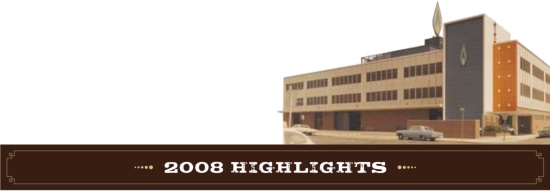
in 2008, nw natural:
• Reported net income of $69.5 million or $2.61 per share.
• Ranked first in the nation among 59 other utilities in the 2008 J.D. Power and Associates Gas Utility Residential Customer Satisfaction Survey.
• Reduced earnings exposure through approval of a new gas cost-sharing mechanism in Oregon.
• Reached an agreement with Oregon regulators authorizing rate recovery for pipeline safety investments.
• Completed a rate case in Washington state increasing revenue requirements by approx $2.7 million a year.
• Sold our Boeing 737 airplane investment that had been leased to a commercial airline since its purchase in the 1980s, disposing of the company’s last noncore asset and recording an aftertax gain of over $1 million.
• Gill Ranch Storage, LLC filed a permit application for approximately 20 billion cubic feet of underground storage capacity and a 27-mile pipeline near Fresno, California.
• Palomar Gas Transmission LLC filed a permit application with the Federal Energy Regulatory Commission to build and operate a 217-mile natural gas pipeline in Oregon.
• Entered an agreement to build a biodigester on Oregon’s largest organic farm with support from Smart Energy, NW Natural’s new and innovative customer carbon offset program.
• Raised the quarterly dividend rate by more than 5 percent, making this the 53rd consecutive year of increasing dividends paid per share.
• Maintained the company’s strong credit ratings from Moody’s and from Standard & Poor’s.
our customer growth rate of 1.6 percent in 2008 still ranked among the highest in the industry.
After 150 years, you learn how to deal with good and bad business cycles. You plan ahead and you execute. This far-sighted approach helped the company transition from lighting to heating early in its history, and it was the reason we were able to deliver a solid performance in 2008.
Three years ago we initiated a comprehensive redesign of our operations, which helped us reduce our work force by more than 10 percent and control costs across the company.
When we started this effort, we intended to size our work force to operate more efficiently. A greater reliance on construction contractors gave us the flexibility needed to rapidly respond to the downturn in housing.
We also created an incentive based sales team. In 2008, the team met our conversion targets, which helped offset the slowdown in new housing starts.
And because of the redesign, and our continuing commitment to managing costs, we were able to offset losses from our gas cost-sharing mechanism caused by the higher price of natural gas in the first seven months of 2008.
In the midst of the nation’s financial turbulence, we kept a strong balance sheet. We set aside a $50 million cash reserve early in the fourth quarter, when markets were unusually volatile. Our total capitalization and liquidity remained solid, as represented by our strong credit ratings: Moody’s at A2, Standard & Poor’s at AA-.
strengthening the core
In 2008, we benefited from the many operating changes made in 2006 and 2007.
But, we also continued to fine tune and improve our operations. New technology and organizational changes came together, advancing our efforts to work more efficiently and effectively.
Last year, employee and contract construction crews began sending and receiving work order information electronically. An automated vehicle location system now helps our newly centralized resource management team direct the closest crew truck to a job site or emergency. In 2009, we will deploy this new technology with other field employees to take full advantage of these systems.
We also spent much of 2008 designing and installing new business software. Since early this year, data entered in the field and in the office now flow into a single integrated system. This is speeding the movement of information, leading to more timely and
accurate reporting and more responsive decision making.
working in partnership with regulators
In 1860, our first year of gas deliveries, cast iron pipes brought gas to the company’s first customers. Today, we use flexible polyethylene or steel pipes with sophisticated cathodic protection. Safety and reliability have always been our highest priority.
In 2009, the federal government is expected to establish new rules for assessing gas distribution pipelines. But well before regulators considered distribution integrity rules, NW Natural had acted on many of the proposed requirements. We were one of the first utilities in the nation to replace all cast iron pipes. And we have had a bare steel removal program in place since 2001.
However, even
with so much of the work behind us, new rules bring additional costs.
For a number of years, the Oregon Public Utility Commission (OPUC) has allowed timely rate recovery of our costs for pipeline safety programs: replacing old pipe before problems arise and implementing pipeline integrity programs to maintain the safety of our existing pipeline system. In early 2009, the OPUC agreed to integrate these programs with the new federal distribution integrity management requirements and provide for annual rate recovery through a new System Integrity Program.
In 2008, we also worked
successfully
with Oregon

 Back
Back